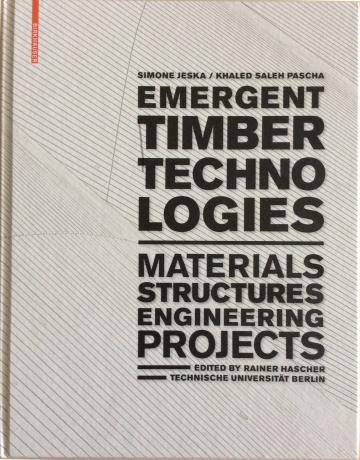
Wood architecture in the modern day is very different from 100 or even 50years ago due to new technology. Advances in computing power, digital design and the development of manufactured timber allow the creation of structures that bear little resemblance to traditional post-and-beam buildings with mortise-and-tenon joints. Emergent Timber Technologies is a book that seeks to explain where the industry is positioned today and what the technologies are that have made it so.
The first thing that must be said about this book is that it is an expert analysis. The language used is very technical and there are no apologies for the demands placed on the reader. Many scientific terms go unexplained, and the context often provides few clues to those who do not know the meaning of these terms. The language is a fairly high barrier to entry into this book, but it is surmountable and if you can gain a bit of an understanding of it, the text provides enormous amounts of information. The book is quite short—around 170 pages—but the technicality of the language and the writers’ focus on their subject leads to very dense writing that contains large amounts of information.
Emergent Timber Technologies uses diagrams and images to illustrate the complicated concepts discussed throughout, but the majority of each page is dedicated to text. That being said, there is a clear design sensibility at work, with large gutters and plenty of negative space providing a clean layout. The diagrams are all clear and uncluttered, the images speak directly to what is being discussed and the addition of many footnotes and references show both the depth of knowledge at play and the quality of that knowledge. This book is an expert text.
The book is divided into two major sections, with the first detailing the technologies that have been developed for the construction of wooden buildings and the second section looking at a variety of case studies that show these technologies in action.
The first section, comprised of the chapters ‘Historic design typologies’, ‘New technologies and methods’, ‘Developments in timber construction materials’, ‘CNC production for timber structures’ and ‘Experimental and temporary structures’, sums up the methods and materials used to create modern wooden buildings. Some of the more influential technologies are manufactured timber, such as glulam or the particularly important cross-laminated timber (CLT), and computer numerical control (CNC) machining. A relatively large portion of the book is set aside to explain CNC, in which computers are used to control a robot that cuts wood into incredibly precise shapes quickly, because this technology makes possible very complicated wooden shapes and structures.
CNC machining is at the heart of the case studies that are the focus of this book’s second half. CNC can be programmed to carve any piece of wood that might be needed to a precision that is beyond what the average human craftsman can achieve. When attempting a structure such as the roof of the elephant house at Zurich Zoo (137), where each individual panel is unique and fits into a specific place in a complicated pattern, CNC machining is by far the easiest manufacturing method.
The second section examines case studies, primarily from Europe, where CNC-machined wood is used in a way that showcases the possibilities provided by these new technologies. Each case study is of a predominantly wooden structure, from a footbridge crossing a German valley (129) to a selection of rollercoasters from Northern Europe (151). The case studies challenge the perception of wood as an lesser structural material and instead rank it equal to steel or concrete—attempting ambitious projects at the outer limits of what CNC and CLT are seen to be capable of and achieving impressive results.
Emergent Timber Technologies is an exploration of the modern wood architecture industry, from materials through construction, conducted by an expert team of authors. This book is not for the faint of heart, as the language used assumes familiarity with architectural and scientific terms. While dense and demanding, the book provides an unassailable font of knowledge about modern wood construction.
